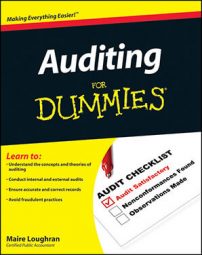You can use sampling to test the strength of a client’s internal controls, but you also use sampling to test account balances. The full name for this process in auditing lingo is sampling for substantive tests of details of account balances. In non-auditing talk, this means the auditor uses sampling to see if the dollar amount on the financial statements for each account is accurate. You also need to make sure that whatever the account balance represents actually exists.
For example, if a client’s vehicle account balance is $150,000 and represents the value of five different cars, you need to make sure that the company actually owns five cars and that their collective value is indeed $150,000. Sometimes companies forget to remove assets from the balance sheet after the assets have been sold or junked.
You’ll encounter five different types of accounts: asset, liability, revenue, expense, and equity. Each is made up of many different individual accounts. For instance, cash and accounts receivable are two examples of asset accounts. Typical expense accounts are rent expense and telephone expense.
Here is an example of how to uses six steps to test account balances using monetary unit sampling for a repairs and maintenance expense account. For this example, the monetary unit sampling value consists of the total dollar amount of repairs and maintenance, and the sampling unit is each dollar shown in the expense.
Determine the test objectives.
In this case, you test the reasonableness of the repair and maintenance expense account balance. You want the tests to provide a reasonable assurance that you’ll find material misstatements and be able to correct the financial statements.
Material misstatements have two sources:
Unintentional mistakes, such as transposition of numbers or keying errors.
Fraud or defalcation, which takes place when accounting data is, for whatever reason, deliberately entered into the system incorrectly.
You’re testing the dollar amount the company assigned to this account to make sure it’s correct. If it’s not correct, you inform management and give management the opportunity to make any needed corrections to the account.
Define your population characteristics.
You already know that repairs and maintenance is an inherently risky expense account. For your audit, you want to test accuracy and classification assertions for repairs and maintenance. You confirm accuracy if transactions are recorded correctly; you confirm proper classification if transactions are recorded in the correct accounts. In the final analysis, you want to make sure this account is materially correct or has no material misstatement.
Determine the sample size.
Regardless of the sampling method used, before you determine how many of those transactions you’re going to sample, you have to consider the risk of incorrect acceptance, confidence level, tolerable error, and expected error.
Select sample items.
Here’s a fast and easy way to pick the sample: Say there are 3,000 records in that group of small-dollar transactions. Divide 3,000 by 75 (the population size/sample size). That equals 40, which is your interval number. Arrange the 3,000 records in some sort of order, using software or some other method to pick a starting point.
Perform audit procedures.
You’ve selected your sample size and pulled your sample from the entire population of records; now it’s time to perform your audit procedures. Audit procedures are quite varied. For example, you could follow transactions that show up in the repairs and maintenance account from the books to the records, such as the paid invoices.
Draw conclusions.
Your last step is to determine whether the account balance is materially correct. If the total misstatements don’t exceed your assessed tolerance level, you can conclude that the account is not materially misstated, and you should feel no need to expand the sample to test more records.

